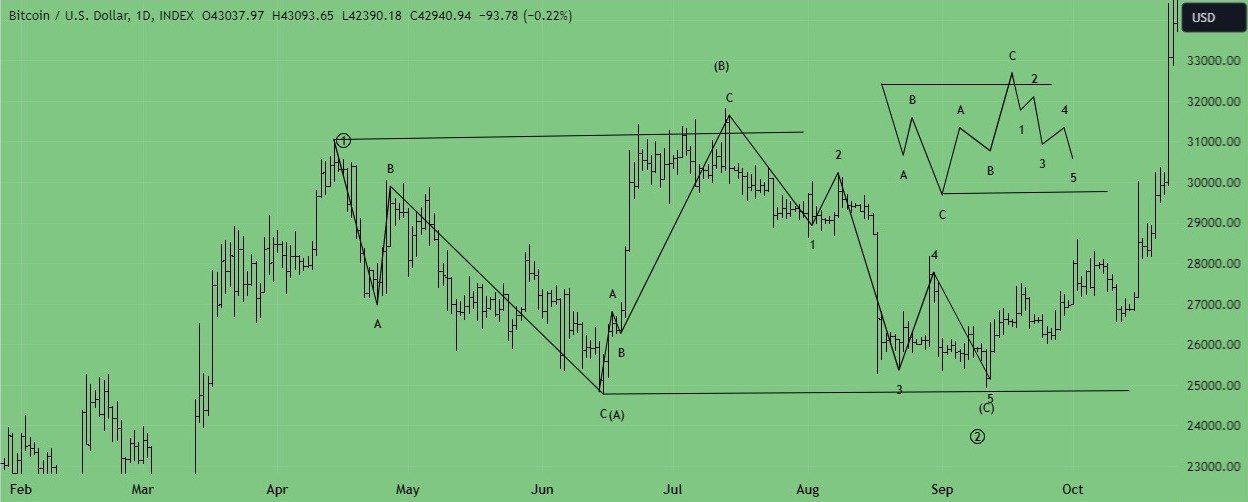Elliott Wave theory describes a flat correction as a three-part movement consisting of three-wave corrective actions in Waves A and B and five-wave movement in Wave C. There are three different kinds of corrections: regular, expanded, and running flat. Flat correction types are a terrific tool for traders looking to make sense of the massive shifts caused by corrective waves.
In Short
Is reading a key corrective pattern something you’re interested in doing to strengthen your trading skills?
The flat correction is essential to understanding market behavior, despite its seeming simplicity. It is a three-wave structure marked A, B, and C. To help you understand the flat correction, we will go over the basic patterns, principles, and standards here.
What Is a Flat Correction in Elliott Wave?
In the world of Elliott Wave, a flat correction is a three-part movement in which both Waves A and B showcase their corrective actions with three waves each. This pattern often exhibits clear performance during small zigzag corrections.
The sole motive pattern, Wave C, also takes center stage in this crucial financial performance. So, keep a watch on those three-wave sequences to figure out the flat corrective pattern!
What Are the Different Types of Flat Corrections?
Flat corrections come in quite a few types, each with its own market movement. The first pattern is the Regular Flat, characterized by a simple A-B-C pattern that upholds a balanced structure.
Then comes the Expanded Flat, in which Wave B exceeds Wave A‘s beginning point, resulting in an elongated corrective.
Finally, we have the Running Flat, which occurs when Wave C continues beyond the end of Wave A, adding an element of unpredictability to the market choreography. So, whether it’s a regular rhythm or a long performance, these flat correction types offer flair to the waves’ amazing movements.
Flat Corrections
Regular Flat | Expanded Flat | Running Flat |
1. Regular Flat
A Regular Flat in Elliott wave is a market phenomenon consisting of three waves, A, B, and C. Waves A and B perform a three-wave routine, while Wave C has five waves. Wave B must finish between 78.6% and 90% of Wave A, but should end below 100%.
Regular Flat Wave Structure
Wave A and Wave B in a Regular Flat each have three sub-waves, making a 3-3-5 structure. Wave C, the final wave, culminates the pattern with its five sub-waves.
It is common for Wave B to retrace 78.6% to 90% of Wave A in a Regular flat. The pattern is characterized by its almost complete retracement as Wave B approaches but does not surpass the beginning of Wave A.
Here, the Regular Flat correction’s C-wave establishes a five-wave sequence, disrupting the previous stability. Wave C will finish the pattern after Wave A has finished, creating a small extension.

REGULAR FLAT
In trading, identifying a Regular Flat allows traders to expect minimal price movement and prepare for probable reversals or consolidations. Recognizing this correction is crucial because it indicates a halt rather than a trend reversal, which guides smart entry and exits in the framework of Elliott Wave Theory.
Rules for Regular Flat patterns
Rule 1 # Wave B must retrace 78 to 90 percent of wave A.
Rule 2 # Wace C must terminate below wave A.
2. Expanded Flat
The Expanded Flat has the same number of sub-waves as a Regular Flat, with 3 waves in A and B and 5 waves in C. In Expanded Flat correction, wave B ends between the inverse of 161 percent of wave A.
Expanded Flat Wave Structure
Expanded Flats, like Regular Flats, have a 3-3-5 structure; in this case, Waves A and B each have three sub-waves, while Wave C has five. This framework guarantees that the corrective pattern will continue, but it also indicates that prices will expand even more.
The second wave, B, in an expanded flat is usually longer and more powerful than the first wave, A. It is characteristic of this pattern for Wave B to retrace anywhere from 100% to 161.8% of Wave A. This extension indicates greater momentum and usually misleads traders into believing the original trend will continue when, in fact, a correction is developing.
In an Expanded Flat correction, Wave C is usually very powerful, often exceeding Wave A’s end. This last five-wave sequence tends to push prices well past the end of Wave A. This makes the pattern more volatile and strengthens the structure‘s corrective nature.

EXPANDED FLAT
Expanded Flats often develop in strong moving markets when the current trend needs a more difficult or prolonged corrective before continuing. Recognizing an Expanded Flat is critical for traders, as the greater-than-usual swings in Waves B and C may serve as key entry and exit positions within the overall trend.
Rules for Expanded Flat patterns
Rule 1 # Wave B must break the starting point of wave A.
Rule 2 # Wave C must terminate below wave A.
3. Running Flat
The Running Flat is the same as the Expanded Flat of the structure, with waves A and B having three waves and Wave C having five waves. In the Running Flat pattern, Wave C must end within the end point of wave A.
Running Flat Wave Structure
As with the Regular and Expanded Flats, the Running Flat has a 3-3-5 structure. Waves A and B each have three sub-waves, while Wave C has five. There is a significant variance in the behavior of Wave C, but this structure nevertheless offers a robust foundation.
In the Running Flat, Wave B extends more assertively, often retracing beyond 100% of Wave A, just like in the Expanded Flat. This big retracement may seem to end the correction, but Wave C will move forward.
Unlike the Expanded Flat, Wave C in a Running Flat ends within the price range of Wave A rather than beyond it. This indicates that Wave C does not reach Wave A’s low or high point (depending on trend direction), resulting in a shorter pattern completion.

RUNNING FLAT
In strong trends, the Running Flat is a useful indication since it indicates the correction is small and the main trend will probably continue. Recognizing a Running Flat allows traders to anticipate tiny corrective swings and prepare for the trend’s resumption, resulting in well-timed entry points within the trend’s overall momentum.
Rules for Running Flat patterns
Rule 1 # Wave B must break the starting point of wave A.
Rule 2 # Wave B cannot cross the inverse of 161% of wave A.
Rule 3 # Wave C must conclude within wave A.
Elliott Wave analysis uses triangle corrections, which are corrective wave patterns with converging trendlines. These triangles usually have five waves—A, B, C, D, and E—each with three subwaves. Read more…
What Is the Difference Between a Running Flat and an Expanded Flat?
| Running Flat Pattern | Expanded Flat Pattern |
|---|---|
| Wave C concludes at the end point of Wave A. | Wave C extends beyond the end point of Wave A. |
| It manifests in robustly trending markets with minimal correction. | Shows higher volatility and deeper retracement. |
| Wave B retraces beyond 100% of Wave A but less than 161.8%. | Wave B often retraces up to 161.8% of Wave A. |
| Signals shallow correction before trend continuation. | The market signals a deeper correction before resuming the trend. |
What Is the Difference Between Zigzag and Flat Correction?
| Wave | Zigzag Correction | Flat Correction |
|---|---|---|
| Characteristics | Wave A and Wave C are motive waves with strong directional moves. | Waves A and B are corrective waves, each consisting of three sub-waves. |
| Pattern | Wave B typically initiates a three-wave pattern, which serves as a corrective slowdown against the trend. | Wave C is a motive wave, showing stronger directional movement than Waves A and B. |
| Structure | The correction produces a clean, three-wave creation known as A, B, and C. | It creates a complicated, sideways three-wave pattern with the labels A, B, and C. |
| Market Behavior | Often signals a stronger corrective move. | It indicates a consolidation phase, suggesting a pause rather than a strong reversal. |
The Story of the 2015–2016 S&P 500 Flat Correction
The S&P 500 ended a strong uptrend in mid-2015. Investors anticipated either a rally or a crash. Many were confused when the market moved sideways for months, with sharp drops and quick rebounds but no direction.
Elliott Wave analysts recognized a familiar pattern: the formation of a flat correction, characterized by a classic 3-wave ABC sequence where
- Wave A experienced a slight decline.
- Wave B retraced almost 100% or even more of Wave A.
- Wave C declined once more, ultimately finishing close to the lows of Wave A.
This flat correction occurred between August 2015 and February 2016, leading to a strong rally in the market that surprised many traders.
Those who recognized the Flat Correction pattern were ready. They understood that once Wave C concluded, a new motive wave could commence.
This real-world event highlights several important lessons:
- Flat corrections appear calm but powerful.
- They often frustrate both bulls and bears, leading to emotional errors.
- Identifying the ABC structure early can prepare you for the upcoming breakout.
Complex corrections include Double and Triple Three. The number of component adjustments determines whether complex corrections are double or triple threes. Read more…
Final Thoughts
Finally, comprehending the complexities of Flat Corrections in Elliott Wave Theory reveals a useful tool for navigating market patterns. Understanding the rules, principles, and specific patterns of Flat Corrections enables traders to forecast and profit from probable market swings. So, ride the waves wisely, prepared to negotiate the ever-changing currents of financial markets.
FAQs
What is the relationship between wave A and wave C in Flat Correction?
In Elliott Wave Theory, Wave A and Wave C form a three-wave pattern in a flat correction. Wave A represents the initial movement, typically three sub-waves. Wave C, the final move, is the decisive motive wave, consisting of five sub-waves. Together, they complete the correction, defining the ultimate resolution.
Can wave 4 be a Flat?
Yes, Wave 4 in Elliott Wave Theory can be a flat correction, as it is part of the larger Elliott Wave sequence and often exhibits corrective patterns. The flat correction typically consists of three waves: A, B, and C. Waves A and B are corrective, while Wave C is a motive wave. This flat correction serves as a temporary interruption before the market continues with the larger Elliott Wave pattern.
Disclaimer
This post is just for informative purposes and does not constitute financial advice. Trading and investing involve risk, and past performance does not guarantee future results. Before making an investing or trading choice, readers should undertake their own research and evaluate their own circumstances. The author and platform accept no responsibility for any financial losses or damages stemming from the use of this material. Receive personalized advice from a qualified financial advisor.













Leave a Reply